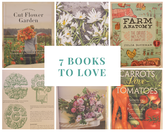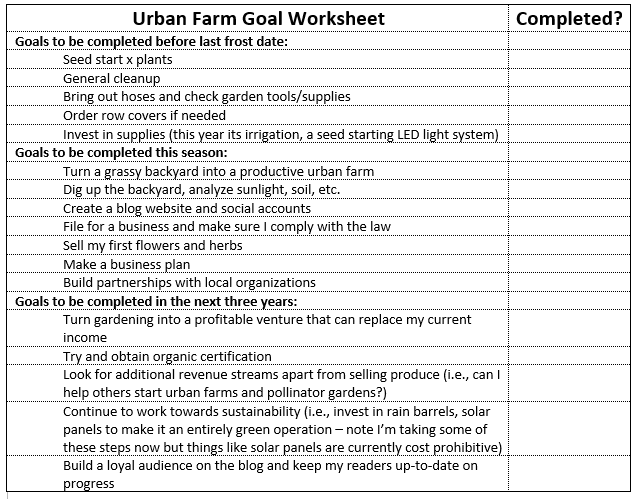 Example: My Google Planting Calendar Example: My Google Planting Calendar The best urban farms start with a plan. While it’s fun to browse your local nursery for plants and pick things up on a whim, an urban farm is a business, and each decision should be considered in this context. I’ll show you a great way to stay organized while you are in the initial stages of designing your plot of land. The steps are easy but there’s a lot to think about, so I documented what worked for me so you can have the confidence to do it yourself. Dream and Research Your Perfect DesignIf you are like me, you’ve spent the last six months reading gardening books, earmarking plant catalogs, and building a farm supply wish list to die for. Now it’s time to make some real decisions about the kind of garden or urban farm you want to have. But before you make any purchases, it’s smart to make a plan first, to make sure you don’t get in over your head with too many plants, or run out of money before you buy the absolute essentials. So many people get overwhelmed at this point, and never start their garden or urban farm, for fear of “not doing it right.” You can do this! Taking your bookmarked design magazines, Pinterest boards and seed lists from dream to reality requires organization and commitment. Therefore, I find it’s always best to spend a lot of time on the research phase or garden design. It helps me get through the off-season, for one, and I consider it an opportunity to research topics that help me determine what will work best for my land, what my favorite plants are, and what my ultimate dream garden looks like. Here are a few of the things I did as I prepared my urban farm plan. Read Books
Meet PeopleA vital component of building the life you want to live is surrounding yourself with a support system of people who have the same goals as you, who think like you and who are also running an urban farm or growing a garden. They will be your professional friends in this venture. Offer advice, friendship, and don’t be afraid to ask the same of them. Visit Gardens in Your AreaVisit botanical gardens, parks, community gardens, homesteads and public farms, go on garden home tours, and more. Take pictures, meet people, get inspired. Here are some of my favorite places if you are ever in Northern Ohio:
Engage On Social Many people are drawn to urban farming because it presents what they see as a more straightforward way of life. It’s a way to get growing, to become self-reliant and to connect with nature — to find a spiritual purpose and the satisfaction of building something positive for yourself and your community. I’m with you on this. However, there are lots of ways to find a community of friends, which is an especially great option if you don’t know anyone who is into urban farming. Some specific tips include:
Set Short and Long-Term GoalsSure, we all want to have a well-developed and productive farm our first season. But the reality is that it takes hard work, infrastructure development, and money to get your property set up for the years ahead. Set some short and long-term goals for yourself. Here’s how I organize this for myself:
Understand Your Land and Map It OutBy now you’ve done your research and identified the goals you want to achieve. Great! Now put pencil to paper. First, you are going to want to walk your land. Measure your plot and map it out on graph paper (or a program like Google Sketchup). Analyze your sunlight in each area and think about what plants you plan to grow and how they’ll fit given their sunlight requirements. Test your soil to see if you need to add amendments or fertilizer. Inventory existing plants either via an app (I recently downloaded the Plants Map app, I’ll have fun experimenting with that) or have a static page on your blog, or have an old-fashioned binder to file them all in. Me, I’m doing all three. Then start to fill in your map with the plants you want to grow, highest priority first. Account for sunlight and structures on your sketch. I designed the plot of my backyard on graph paper, but plan to go high tech and put it into Google Sketchup soon. I also counted each small square as one square foot on the paper. Then I cut out tiny plots of plants in circles or rows and labeled them. After I did that, I was able to move those clips of paper around on my map, shifting the design effortlessly to determine where I wanted to plant things. Then, once that was settled I drew the plants into the design. Calendar Dates and Create Lists Now that you have your garden design make a list of all of the seeds and plants you’ll need to purchase for the year, so you can prepare your orders as budget allows. Lastly, I’d create a calendar of all of the tasks that you need to accomplish in the garden. I created a Google calendar for this, since it’s online and you can create a unique schedule just for the farm tasks, I found it incredibly efficient. I added my short and long-term goals in there, as well as first and last frost dates, and finally, I documented each day that I needed to either start a seed or transplant out into the garden. So for example, if I look at my calendar it’ll show me exactly when to direct-sow my chamomile, or when I can transplant my sweet-peas. Calendaring should be a fundamental part of your garden design and plan because it sets the stage for next year. For example, if you are like a lot of us, and get excited for Spring and plant things only to have them decimated by a frost, you can move your calendar date back a week next year, and see if you have better luck. I set each of my calendar events to recur yearly for this purpose. Next year all my plants are already organized in the calendar, and I’ll adjust and optimize dates based on how my urban farm performed this year. Get Started!These tips should help you design out your urban farm plan. Do your research, take your wish list into account, visit places and meet people that inspire you, set your goals and map out your farm. You can’t always predict success, especially in farming, but with a solid plan, you’ll be on a right path to get growing.
Comments are closed.
|
About UsThis is a blog about turning lawns into edible gardens, providing a habitat for pollinators and living a more sustainable life. We hope to inspire others to plant a garden to save the world. CategoriesArchives
September 2018
© Copyright 2018 Wildflower Lab
|
||||||||



